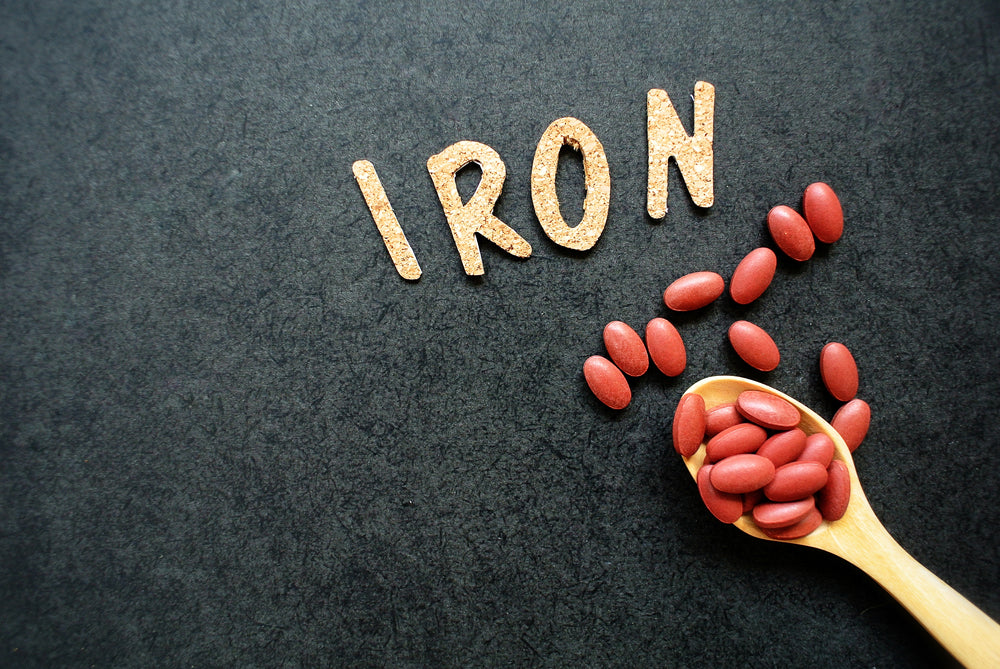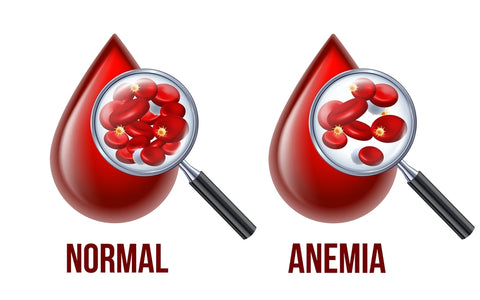Your cart is empty
Free shipping on all US orders


Free shipping on all orders

Did you know that iron is the most abundant mineral on Earth? It's true! Iron is found in every single cell of the human body and plays a vital role in our overall health. But what exactly does iron do, and how much do we need? Here's everything you need to know about this important nutrient.
Iron is a mineral that our bodies need to function properly. It's present in every single cell of the body and plays a vital role in many different functions, including the production of hemoglobin (which carries oxygen in the blood) and myoglobin (which helps muscle cells store oxygen). Iron also aids in the production of collagen (which helps keep skin healthy), enzymes (which are needed for many biochemical reactions), and hormones (such as adrenaline).
The amount of iron we need each day depends on our age, gender, and health status. For example, pregnant women need more iron than non-pregnant women, and children need more iron than adults. Most healthy adults require between 8 and 18 milligrams of iron each day.
There are two main types of dietary iron: heme and non-heme iron. Heme iron, which makes up 40 percent (typically) of the iron in meat, poultry, and fish, is well absorbed by the body.

Non-heme iron, on the other hand, which makes up 60 percent of the iron in plants (such as beans, lentils, and spinach) and fortified foods (such as cereal and pasta), is not as well absorbed. That being said, our bodies can absorb up to 35 percent of non-heme iron if we consume it with a food or supplement that contains vitamin C ( such as citrus fruits or tomatoes).
Iron is an essential component of life, and it has a critical role in many biochemical processes. One of the most important functions of iron is its involvement in hemoglobin production.

Hemoglobin is a protein found in red blood cells, and it carries oxygen from the lungs to other parts of the body. Without it, vital organs like the brain and heart would be unable to function properly. Iron helps with the production of hemoglobin by playing a role in the formation of new red blood cells. Specifically, when iron binds with certain proteins, it forms an essential component of heme, which is part of each hemoglobin molecule. In addition, iron helps this molecule bind oxygen molecules as they pass through cell walls and into circulation.
Did you know that Iron helps to protect against many illnesses and diseases? Yes, iron boosts immunity by allowing more white blood cells to be produced. White blood cells are responsible for hunting down foreign pathogens and attacking them so that they cannot cause harm.
Without enough iron, our bodies would not be able to produce enough white blood cells, leaving us vulnerable to numerous viruses and other illnesses.
Additionally, when there isn’t sufficient iron in our system, some of the body's existing white blood cells start to weaken—a side effect commonly associated with leukopenia. This reduces our chances of warding off harmful pathogens even further. Iron is crucial for immune health because it aids in building and strengthening the structure of red blood cells, allowing them to carry oxygen more efficiently throughout the body. By having more oxygen present, our bodies can fight infectious microorganisms that try to invade us more quickly and efficiently, giving us better protection against illness-causing invaders.
With steady levels of iron, our bodies can function optimally; without it we can become easily susceptible to sicknesses and infections which charge with feverish intensity.
Iron plays an essential role in maintaining the health of our hair, skin, and nails. This nutrient helps to regulate cell growth, improve blood circulation and ensure optimal levels of oxygen are reaching these areas of the body.
As a result, hair looks fuller and healthier, the skin maintains its glow, and nails, their hardness. Not surprisingly, iron deficiency can cause numerous problems in all three of these areas. It may lead to weak or brittle nails that break easily, dull-looking hair that loses its shine and smoothness, and pale skin with more wrinkles than expected.
Combined with Radiance collagen peptides, you can be assured of the health of these important connective tissue types.
Iron helps to regulate the release of heat in our body by absorbing excess heat energy stored in the cells and releasing it when needed. Heat energy stored in the cells is used for various processes such as metabolism, respiration, digestion, and muscle contraction (the shivering response).
When there is an increase in body temperature, iron buffers this extra heat and protects the cells from damage due to high temperatures. This helps to keep our body temperature within a normal range so we don’t become overheated or dehydrated.
A lack of adequate iron means that our body cannot properly buffer up excess heat, resulting in an increased risk of febrile-type illnesses.
In addition, the anemia which may be brought on by iron deficiency tends to make it difficult to raise core temperature in response to cold stressors, leading to sometimes fatal hypothermia.
Iron takes part in several chemical reactions, activating specific enzymes to catalyze metabolic processes such as respiration and digestion. It also helps to transport oxygen through the blood—essential for energy production—while preventing oxygen molecules from reacting with other molecules.
In addition, iron plays an important role in hormone production by attaching itself to proteins, and acting as a cofactor that helps convert molecules into hormone precursors. Finally, it facilitates the action of certain enzyme-bound hormones like thyroxine, which helps regulate metabolic rate and energy utilization.
As such, iron is critical for its action as a mediator in several enzymatic and hormonal systems.
Iron plays an essential role in the growth and differentiation of cells. This essential nutrient helps to fuel cell metabolism as it supports the production of energy through the generation of adenosine triphosphate (ATP).
Without sufficient iron, cells would be unable to perform their basic functions including the maturation of red blood cells and regulation of serotonin and dopamine production in the brain.
In terms of growth and differentiation, iron helps to regulate cell division as well as gene expression that occurs during organ development.
Lastly, iron also helps to maintain cell stability during environmental stress, which can make a big difference when it comes to preventing damage during growth or evaluating responses due to different stimuli.
As living cells age, their ability to efficiently carry out normal functions diminishes and they become increasingly subject to the effect of oxidative stress caused by free radicals.
Oxidative damage is a major contributor to several chronic illnesses including heart disease, and the presence of free radicals can result in damaged cells, proteins, and even genes.
Fortunately, iron can help reduce oxidative stress and its resulting damage. Iron’s most powerful contribution lies in its role as a cofactor for enzymes that help create antioxidants in our body like superoxide dismutase, (SOD) which helps break down oxygen molecules into non-toxic compounds. Iron also helps produce two other important antioxidants - glutathione peroxidase and catalase - which limit the damage caused by cell membrane breakdown due to long-term oxidation.
By supporting these different enzyme processes linked to antioxidant production, iron plays an essential part in helping our bodies stay healthy and reducing oxidative damage. Additionally, it's important to note that too much iron can be damaging so it’s important to ensure proper levels are maintained through diet or supplements if necessary- more is not better when it comes to iron.
It turns out that this versatile nutrient also plays a major role in healthy cognitive function. In one British study published in 2012, researchers looked at the correlation between ferritin levels (a measure of stored iron) and children's performance on IQ tests -- with those higher in ferritin demonstrating higher scores on verbal and non-verbal reasoning tests.
Iron is also necessary for good cognitive function since it helps your body produce neurotransmitters like noradrenalin, serotonin, and dopamine which are key for thinking clearly, memory retention, focus, and problem-solving.
A lack of iron can cause symptoms such as mental exhaustion, poor concentration, and decreased learning capacity– which is why getting adequate amounts of iron-rich foods (like liver or spinach for example) is so important for healthy brain functioning in developing kids. It's clear that iron does more than just carry oxygen; it’s also a key element when it comes to staying mentally sharp!
However, when it comes to the elderly population, it might be even more important. As humans age, brain cell turnover begins to slow down, leading to a decrease in the generation of new neural connections.

A lack of iron can worsen this problem, as it has been found to be essential for activating enzymes associated with protein synthesis and DNA replication—processes necessary for neuron formation and communication.
Among people over age 65, those with iron deficiency have been found to have lower scores on memory and processing speed tests. In addition to helping form these new neurons, having sufficient iron levels can also help the brain more efficiently use glucose, providing additional energy during periods of increased cognition demand. By getting enough iron throughout life – but especially in later years – we can ensure our brains stay fit and healthy as we age. Taking steps to ensure that iron intake is maintained within normal ranges can go a long way toward keeping the mind sharp, regardless of age.
Iron plays an important role in physical performance, as it helps our bodies get the oxygen they need to function at their best. Iron is a component of hemoglobin, which is responsible for carrying oxygen from the lungs to the cells throughout our body.
Without sufficient iron, our muscles won't be able to perform for very long before fatiguing. Additionally, iron is also essential for energy production; when iron stores are too low, it can cause feelings of fatigue even at rest. That's why it's so important to make sure you have enough iron in your diet if you're looking to boost your physical performance.
As many people know, anemia can be uncomfortable, affecting energy levels and overall health. But for others, no overt symptoms ever really manifest.
Anemia is caused by a lack of iron in the bloodstream and oftentimes this can be remedied by incorporating more iron-rich foods into one's diet. Iron plays an important role in forming hemoglobin, which transports oxygen from the lungs to muscles, tissues, and organs throughout the body.

Hemoglobin is important for delivering the oxygen needed for cellular respiration and energy production in cells, so iron deficiency can quickly lead to feelings of tiredness or fatigue. Sufficient amounts of iron can help those with anemia feel better quickly so it’s important to increase your dietary intake of iron if you’re feeling unusually fatigued or weak. Iron supplementation in pill form may also be necessary depending on the severity – speak with your doctor for advice on whether or not daily supplementation is right for you.
Despite following all dietary recommendations, however, it may still take some time before symptoms improve -- it can take as long as 120 days for new red blood cell formation, so patience is key. In any case, incorporating foods high in iron into your diet is one way to ensure that our bodies have adequate nutrition to prevent anemia in the first place and keep us feeling energized throughout our days.
Iron doesn't get the recognition it deserves, even though it serves so many important functions in the body. From helping to form new neurons in the brain to carrying oxygen throughout our bodies, iron is essential for a myriad of bodily processes and should be given due credit. Incorporating plenty of iron-rich foods into our diets can help us stay healthy and energized well into old age – something we can all benefit from!